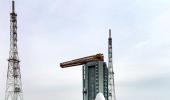The orbit of Chandrayaan-2's landing module 'Vikram' was successfully lowered for the first time on Tuesday and one final manoeuvre remained for India to pull off a historic soft-landing on the moon in the early hours of Saturday.

The 4-second de-orbiting operation was undertaken a day after the indigenously developed lander was separated from Chandrayaan-2's orbiter in a major milestone pushing India's second lunar mission into its last and most crucial leg--a controlled, soft-landing on the Moon
The propulsion system on-board the lander was fired for the first time to lower its orbit after it started orbiting the moon independently, said the Indian Space Research Organisation.
So far, all operations in the journey to the moon were carried out by the main orbiter of the 3,840-kg Chandrayaan-2 spacecraft that was launched into the earth's orbit on July 22 by the country's Geosynchronous Satellite Launch Vehicle, GSLV MkIII-M1.
The ISRO will perform one more de-orbiting manoeuvre on Wednesday, before the powered descent of 'Vikram' on September 7 for its landing in the lunar south pole.
A successful landing will make India the fourth country after Russia, the US and China to achieve a soft landing on the moon. But it will be the first to launch a mission to the unexplored south pole of the Moon.
"The first de-orbiting manoeuvre for Chandrayaan-2 spacecraft was performed successfully today (September 03, 2019) beginning at 0850 hrs IST as planned, using the onboard propulsion system. The duration of the manoeuvre was 4 seconds," the ISRO said giving the latest update on the Rs 978 crore Chandrayaan-2 mission.
"The orbit of 'Vikram' Lander is 104 km x 128 km. Chandrayaan-2 Orbiter continues to orbit the Moon in the existing orbit and both the Orbiter and Lander are healthy," it said, adding that the second and final manoeuvre to further lower the orbit is scheduled on September 4 between 3.30 and 4.30 am IST.
'Vikram' (with rover 'Pragyan' housed inside) is expected to touch down on the surface of the moon on September 7, between 1.30 and 2.30 am.
ISRO chairman K Sivan has said the proposed soft-landing on the Moon is going to be a "terrifying" moment as it is something the space agency has not done before while the Lunar Orbit Insertion(LOI)manoeuvre was successfully carried out during the previous Chandrayaan-1 mission.
Following the landing, the rover 'Pragyan' will roll out from the lander between 5.30 and 6.30 am on September 7, and carry out experiments on the lunar surface for a period of one lunar day, which is equal to 14 earth days.
The mission life of the lander is also one lunar day, while the orbiter will continue its mission for a year.
Chandrayaan-2 satellite had began its journey towards the moon leaving the earth's orbit in the dark hours on August 14, after a crucial manoeuvre called Trans Lunar Insertion (TLI) that was carried out by ISRO to place the spacecraft on "Lunar Transfer Trajectory."
In a major milestone, the spacecraft had successfully entered the lunar orbit on August 20 by performing the LOI operation.
The health of the spacecraft is being continuously monitored from the Mission Operations Complex (MOX) at ISRO Telemetry, Tracking and Command Network (ISTRAC) in Bengaluru with support from Indian Deep Space Network antennas at Bylalu, near Bengaluru, the space agency has said.
The orbiter carries eight scientific payloads for mapping the lunar surface and studying the exosphere (outer atmosphere) of the Moon while the lander carries three scientific payloads to conduct surface and subsurface science experiments.
The rover carries two payloads to enhance the understanding of the lunar surface.
According to the ISRO, the objective of the mission is to develop and demonstrate the key technologies for end-to-end lunar mission capability, including soft-landing and roving on the lunar surface.
On the science front, this mission aims to further expand knowledge about the moon through a detailed study of its topography, mineralogy, surface chemical composition, thermo-physical characteristics and atmosphere, leading to a better understanding of the origin and evolution of the moon, the space agency had said.












 © 2025
© 2025